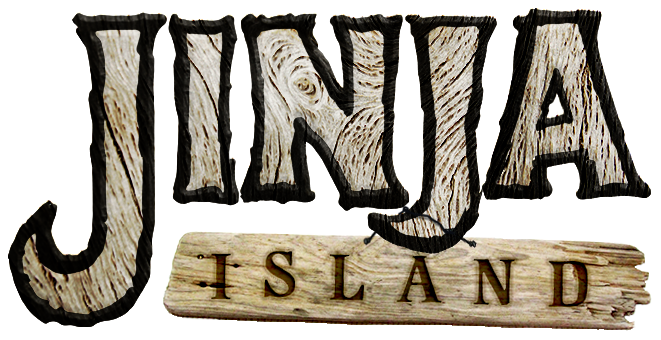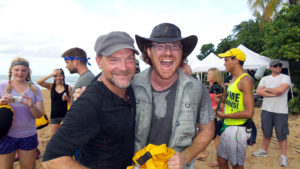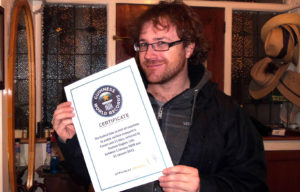
FAQs
Menu
Where is Jinja Island?
Jinja Island is located in the heart of the Bocas Del Toro archipelago of north-western Panama. You can find it by simply Googling “Jinja Island”.
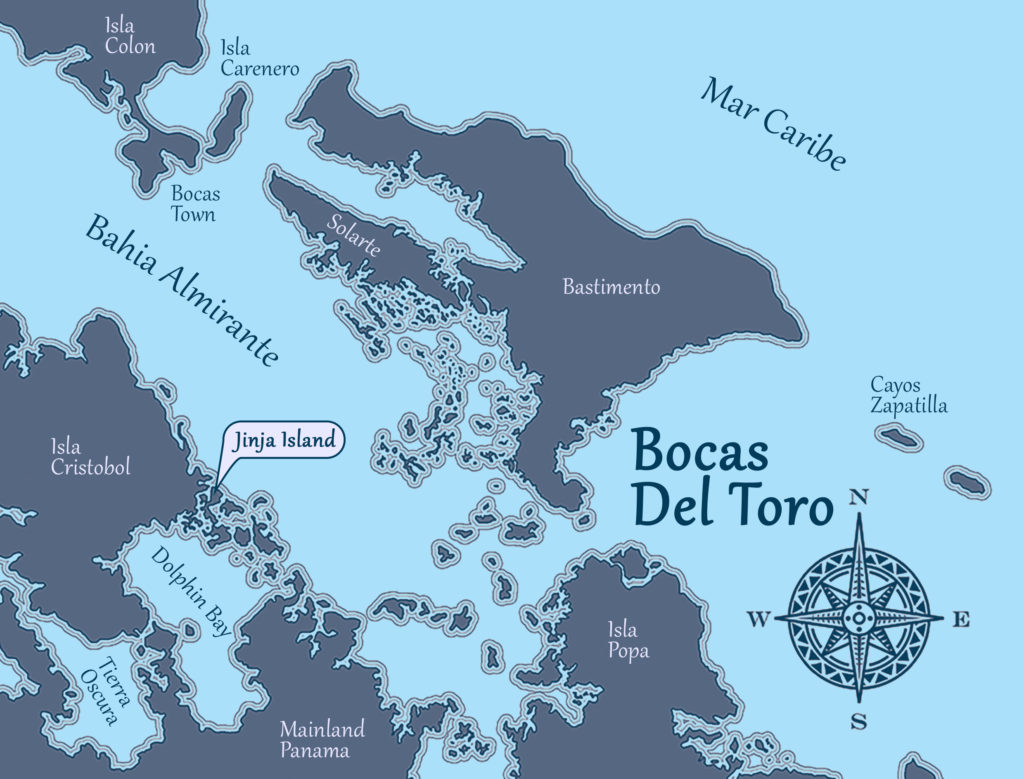
Jinja Island is positioned just off the east coast of Isla Cristobal and 10km due south of Isla Colon, the main island in the archipelago. The town of Bocas Del Toro is situated on the southern tip of Isla Colon. Bocas Town has an airport, hardware stores, supermarkets and a vibrant nightlife.
Both Cristobal and Colon are named after Christopher Columbus, who came here on his fourth and final voyage to the new world in 1502. “Bocas Del Toro” means “The Mouths of the Bull”.
Jinja Island is direct line-of-sight of Bocas Town. This offers several advantages over other locations, chiefly the fact that it is possible to travel to and from the island after dark.
How Do I Get To Bocas Del Toro?
1. Fly all the way
There are direct flights to Tocumen International, Panama City (PTY) from the USA, Central America, South America and Europe, as well as flights from the UK that connect via Amsterdam (KLM), Paris (Air France) and/or Madrid (Iberia).
It’s a 35-50 minute taxi ride from Tocumen Airport to Albrook Gelabert Airport (PAC). There you can fly direct to Bocas Del Toro (45 mins), landing just a short walk from the taxi dock. Tickets may be booked through the AirPanama site.
Please note: flights to Bocas don’t usually fly at night (after 6pm), so depending on what time you arrive at Tocumen, you might have to stay the night in Panama City, or you can take an overnight bus instead.
2. Fly, then coach
Via Panama City
It’s a 35-50 minute taxi ride from Tocumen International Airport to Albrook Coach Station (Estacion Puma Albrook). If you’re strapped for cash and/or feeling brave, you can take the local bus to Albrook Coach State instead. Get a 3-In-One Metro card from the vending machine in Arrivals, walk out of the building, turn right and follow the footpath. Once you exit the main gate, the bus stop is over the two roads to your left. The bus you want will say “ALBROOK” on the front. The driver will probably be a maniac. Good luck!
From Albrook Coach Station you can take a few different overnight buses to Almirante (10hrs), leaving at various hours throughout the evening. Overnight is really the only option here: if you travel during the day, by the time you get to Almirante, the boats to Bocas will have stopped for the night, and you don’t want to spend the night in Almirante. It sucks.
If you miss the direct bus (or it’s full), you can take a bus to David City (6hrs) and change there for a minibus to Almirante. But be warned: it’s a bit of a faff, it’ll be be middle of the night when you get there and the minibuses tend to cram their passengers in.
Almirante is the port town from where you can take the fast ferry to Bocas Town. After getting off the bus, take a taxi to the docks ($1) and from there you have the choice of three ferry companies; just check which one is going next.
Via San Jose
Alternatively, you can fly into San Jose, Costa Rica. It’s seriously worth checking as you might save a few bob on your flights, plus it’s arguably quicker and easier to get to Bocas from there on the coach.
If your flight arrives in the afternoon, you’ll probably have to stay the night in San Jose. In the morning there are a few buses that run to the town of Sixaola on the border with Panama. Try to leave before 9am as you need to arrive at the Panamanian port town of Almirante before dark, and Panama’s time zone is an hour ahead of Costa Rica’s.
If you can’t find a bus to Sixaola, take a bus to Puerto Limon or Puerto Viejo, you’ll be able to find local transport to the border from there.
On the border with Panama, you have to get stamped out of Costa Rica before you cross the bridge over the River Sixaola. After you cross the bridge you have to pay a small entry tax before they’ll stamp you into Panama. Make sure you get stamped in though, they check a few miles down the road! Don’t forget to put your watch an hour forward.
There’ll be minibuses running to Almirante, from where you can get the fast ferry / big speedboat to Bocas Town until around 6pm.
3. Overland
From North America
Get to Mexico through Texas or California. From Mexico City you can get a direct bus to Guatemala City. From there you can buy a ticket to San Jose in Costa Rica, changing in San Salvador, possibly at some ungodly hour. From there it’s the same as above from San Jose.
If you’re driving down, please note vehicles seldom cross at Sixaola, you’re best crossing from Costa Rica into Panama at Paso Canoas and then travelling to Almirante via David city. There is a big car ferry that makes the journey over to Bocas Town once or twice a day.
From South America
There is no way of travelling from South America to Panama overland. Well, no safe way. The Darien Gap, which separates Panama from Colombia is a dangerous part of the world. I would not recommend crossing it. Instead, take a boat from Colombia to the San Blas islands of Panama. You can either catch a lift on a yacht from Cartagena or take a speedboat from Capurganá. Be sure to go with (a) reputable company though!
4. Over Sea
On A Yacht
If you’re coming from over the Pacific, you’ll have to travel through the Panama Canal. Your pilotage will be charged by weight, so maybe drop off anything really heavy you can live without with a friend in Panama City before you travel through. Then it’s just a case of skirting up the coast from Colon to Bocas Del Toro.
If you’re coming from the Atlantic / Caribbean side, there’s nothing in your way except cool blue ocean waves. Fair winds, voyager!
Upon arrival in Bocas, you will need to put up your quarantine flag and stop at the anchorage just north of Bocas Town, near El Ultimo Refugio.
On A Cargo Ship
Several megatons of ships pass through the Panama Canal every day, so if you can get a lift on one, fab. Although bear in mind there is no road between the city of Colon and Bocas, so no matter if you come from the Atlantic side or the Pacific side, you’ll have to get to Bocas Del Toro via Panama City.
An alternative if you’re coming down from Mexico, Cuba or Jamaica would be to get off at Puerto Limon in Costa Rica, which is only a few hours from Bocas by bus.
How Do I Get to Jinja Island?
Once you arrive in Bocas Town, whether by boat or by plane, make your way to the Watertaxi Stop. You can find it on Google Maps. From there, you can take a taxi boat for $25-$35 to Jinja Island. The taxi guys should know where it is. If not, ask to speak to Ariel.
If you’re on your own, a cheaper alternative might be to ask the people doing tours to Dolphin Bay if they wouldn’t mind dropping you off at Jinja along the way. If their boat isn’t full, they’re usually happy to do it for $10.
How much does it cost to get there?
Return flights from the USA to Panama City (Fort Lauderdale, New York, Houston etc) start at $150.
Return flights from Europe to Panama City start from £380 (€400).
Domestic flights from Panama City to Bocas Del Toro are around $150 return.
Coach & Ferry from Panama City to Bocas Del Toro costs around $30 one-way.
A watertaxi from Bocas Del Toro to Jinja Island will cost $20 to $35 one-way.
Where can I park my sailboat?
The location of Jinja island is 9.252532, -82.233897 or 9°15’09.1″N, 82°14’02.0″W. Once you’ve checked into Bocas and cleared quarantine, there is a perfect spot to the south-east of Jinja Island for anchoring your yacht (and watching the sun rise).
While pangas and speedboats can travel into the lagoon of the main boat dock, Jinja Island’s fringing reef makes that approach unsuitable for bigger boats. In order to get to the anchorage safely, I recommend that you avoid the shallow reef that connects Jinja to its neighbour to the south west by travelling around the other island and pulling up around 50m from Jinja’s East (Gravel) Dock.
To check tides, head to http://www.tide-forecast.com/locations/Bocas-del-Toro-Almirante-Bay-Panama/tides/latest.

How long can I stay in Panama?
Citizens of the US, Canada, the EU, Australia and New Zealand can stay up to six months without a visa.
How big is Jinja Island?
It’s 2.2 acres, that’s just under 1 hectare or about the size of two football pitches.
Hang on a minute, it looks way bigger on Google Maps!
That’s because Google assumes that the mangrove forest that extends out to the southwest of Jinja Island is land. It’s not, it’s a dense mangrove forest! Don’t worry, Jinja is still a good size for an island. In fact, it is the biggest private island to be within 10km and in direct line-of-sight of Bocas Town.
What activities are there on the island?
Jinja Island is a chill-out destination, it’s all about disconnecting from the outside world for a few days. You can snorkel the reef, float in the bay, listen to music and drink cocktails on the hammocks. Dolphin Bay is just around the corner, and the island is ideally placed for quick, easy access to all the beaches and activities the Bocas Del Toro archipelago has to offer.
If you’re feeling energetic you can try getting into a coconut with a machete or paddle a wooden kayak (a cayuco) around the island.
Can I swim around the island?
The warm waters of the tranquil bay around the boat dock is perfect for swimming, as are the two coral reefs that fringe the northern side of the island. The mangrove forest to the south west of the island extends over 1km into Dolphin Bay and speed boats plough through the channel at a great rate of knots… I would not recommend swimming that far! Take a kayak.
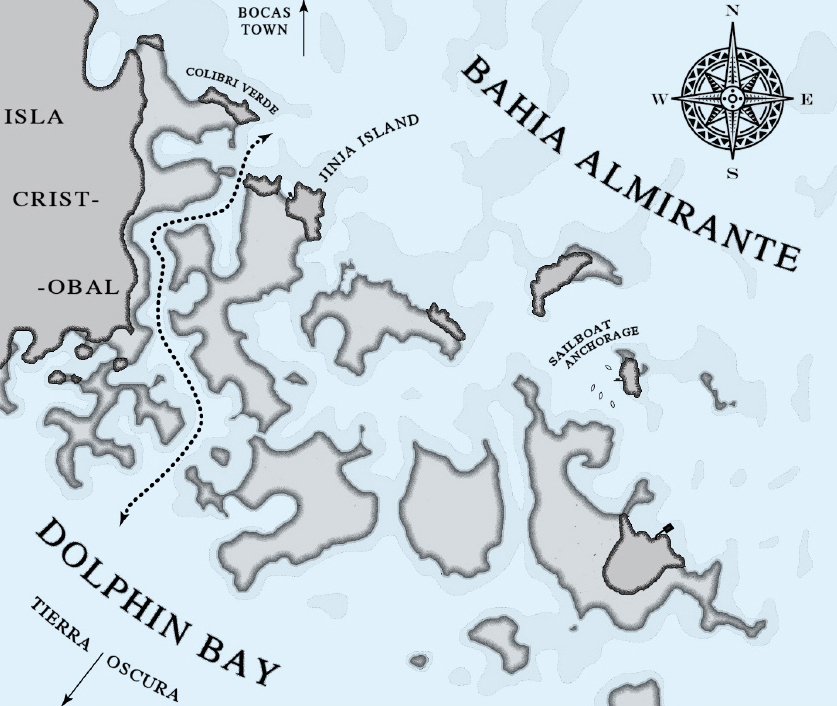
What is there to do in Bocas?
What isn’t there to do? Activities include:
Scuba Diving, Swimming, Snorkelling, Surfing, Sunbathing, Flyboarding, Longboarding, Paddleboarding, Fishing, Kayaking, Water-skiing, Jet-skiing, Zip-lining, Quad-biking, Jungle Trekking, Horse Riding, Birdwatching, Camping, Beach Barbecues, Live Music, Mardi Gras, Chocolate Farm Tours, Fine Dining, Nightlife, Street Food, Turtle Tours and Sailing.
What’s the weather like?
It’s either sunny and hot or raining and hot. It’s ridiculously changeable! However, the temperature never drops below 20°C and rarely tops 30°C. We don’t have major storms in this part of the world and many yachties use the Bocas Del Toro to store their boats during hurricane season in the rest of the Caribbean.
Where's the beach?
There are world-class beaches all over the Bocas Del Toro archipelago, readily accessible by boat. These are the Zapatillas, Red Frog beach, Wizard beach, Bluff beach and Starfish beach. There is no beach on Jinja Island itself. A small beach could be made near the main boat dock without much difficulty, but it would require the removal of a few mangrove trees, so it would have to done in a considered and sensitive way.
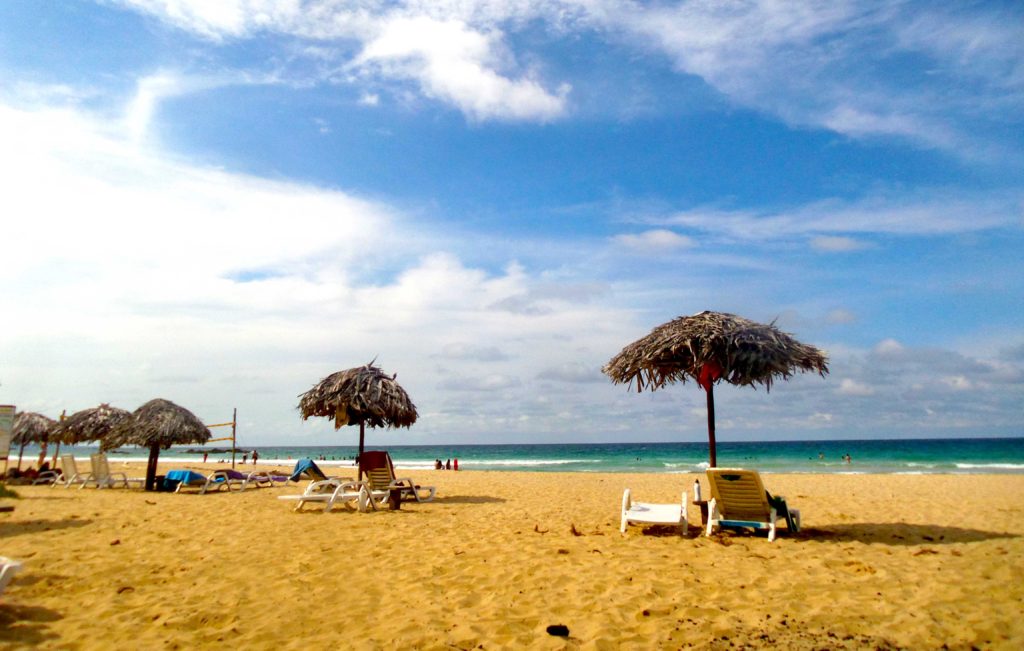
Why are the mangroves so important?
The island is a mangrove island. The mangroves are (quite rightly) protected by law. They don’t just provide shelter, protection from erosion, privacy and clean the water, they also provide an incredible carbon “sink”, an important component in the fight against climate change.
To put this into context, the mangroves immediately surrounding Jinja Island store around 1,842 metric tons of CO₂. That’s the equivalent of the emissions that would be created if you drove your car to the moon and back ten times. (Source)
What about rising water levels?
This is a very real concern that we have to address. No point on the island is more than a foot (30cm) above sea-level. Therefore everything built on Jinja Island will of course be a few feet from the ground and there will be a concerted effort to mitigate rising tides over the next couple of decades, such as building a small levee along the windward side of the island. Over time, soil from neighbouring Isla Cristobal can be brought over on barges to gradually raise the entire island.
How many people could the island accommodate?
With new cabanas, solar panels, rain water collection tanks and facilities, Jinja Island could comfortably accommodate up to 20 guests at a time.
What are the rules about building on the island?
So long as we get planning permission, we can build whatever we like on the island itself. The process is fairly straightforward. If we wish to build on the water we must apply for what is called a “concession”. This is a little more complex and costs more, but it’s eminently possible.
How does the island generate power?
The power for lighting, fans, refrigeration and air conditioning will all come from a new generation solar panel array. These are easy to maintain and will provide more than enough power. When I lived on the island, the battery bank was generally full by early afternoon, even on cloudy days.
The power for cooking, hot water and hot showers will be gas which can be bought in Bocas Town.
There will be a back-up petrol generator, just in case!
What about fresh water?
It falls from the sky! The Bocas area gets a whopping 136.1″ or 345cm of rain a year. By comparison, Manchester in the UK, which is renowned for its rain, gets just 36.6″ or 92cm a year. The rain is collected in large tanks and is treated in a safe and environmentally friendly way before use.
Internet?
Of course! The island is perfectly located to get a strong mobile phone signal and therefore 4G internet access of up to 14 Mbps.
The company PaNETma offers a super-fast broadband service for small businesses that are “line-of-sight” of Bocas Town, like Jinja Island. They advertise internet speeds of up to 100 Mbps at a reasonable cost.
What’s it like for bugs?
Jinja Island is located in the tropical jungle, nine degrees north of the equator, with everything that entails. However, on Jinja itself, there are few mosquitoes. The biggest headache are the tiny sand flies, AKA ‘chitras’ or ‘no-see-ums’, which come out mostly at dawn and dusk.
During “The Itching Hour”, long trousers are recommended, as is insect repellent (preferably with Deet). Retreating to the house, closing all doors and windows and lighting mosquito coils helps keep the little bitey bastards at bay.
What if somebody gets seriously ill or injures themselves?
There is an ER at the hospital in Bocas Town, 20 minutes away by boat, any time of the day or night. In an extreme emergency, there is a helicopter landing pad on the island.
Are there any diseases I should be worried about?
There is little to no risk of malaria in Bocas Del Toro. Zika is an issue, and I would advise against visiting Panama while pregnant. There is no Yellow Fever in Panama, and no requirement to be vaccinated against it for entry.
If you were staying on one of the bigger islands, then leishmaniasis — a nasty flesh-eating parasite — would be of concern, but on Jinja Island you are safe as it requires a sand fly to bite a sick sloth and then to bite you. Happily (but also sadly) there are no sloths on Jinja Island.
Are there dangerous animals on or around the island?
There are no snakes, crocodiles or big sharks. If we’ve had a few very hot few days then there might be jellyfish in the water around the reef. There are a few spiders dotted around the island, but none that can cause any serious harm. They also don’t get anywhere near the house: the geckos won’t let them! Occasionally we’ll find a scorpion scurrying about – always check your shoes before putting them on.
Is Jinja Island as awesome as it looks?
You better believe it!

